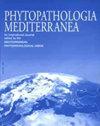小麦锈菌和小麦锈菌对西班牙南部硬粒小麦的毒力,从2020年到2022年
IF 1.9
3区 农林科学
Q2 AGRONOMY
引用次数: 0
摘要
叶锈病是西班牙南部主要的小麦病害,硬粒小麦是西班牙南部的重要作物。直到2019/2020年,由于西班牙南部最广泛种植的品种具有有效的抗性基因,这种疾病得到了有效的管理。2020年春天出现了一个问题,当时所有的农田和硬粒小麦都出现了叶锈病症状。与普通小麦锈菌引起的叶锈病不同,叶片上有较大但较少的尿尿脓疱,且短时间内迅速发育。这些症状明显符合小麦叶锈病,这是地中海盆地西部已报道的另一种小麦叶锈病。这种病害在西班牙南部并不新鲜,但从未在该地区几乎所有硬粒小麦品种上观察到如此严重的病害。在2020年、2021年和2022年三个生长季节,在西班牙南部四个省的硬粒小麦田间试验中评估了叶锈病的严重程度。2020年和2021年,从不同品种的硬粒小麦中采集到13株叶锈病单脓疱分离株。在不同的寄主上接种分离物,发现有4个不同的小种,其中2个是tritrii -duri小种。在本研究中,只有卡莱罗(Calero)品种对稻瘟病小种具有一致的抗性。本文章由计算机程序翻译,如有差异,请以英文原文为准。
Virulence of Puccinia triticina and Puccinia tritici-duri on durum wheat in southern Spain, from 2020 to 2022
Leaf rust is a major wheat disease in southern Spain, where durum wheat is an important crop. Until the 2019/2020 season, this disease was effectively managed, as the most widely planted cultivars in southern Spain had effective resistance genes. A problem arose in the spring of 2020, when every farm field and durum wheat trial examined displayed leaf rust symptoms. Leaves had few but large uredinial pustules, different from those of the normal leaf rust caused by Puccinia triticina, and telia developed rapidly after only a few days. The symptoms clearly fitted with P. tritici-duri, another wheat leaf rust species already reported in the western Mediterranean Basin. This species is not new in southern Spain but has never been observed at such high severity on almost every durum wheat cultivar grown in that region. Leaf rust severity was assessed in durum wheat field trials in the 2020, 2021 and 2022 growing seasons in four provinces of southern Spain. During 2020 and 2021, 13 single pustule isolates of leaf rust were also collected from different cultivars of durum wheat. Inoculation of the isolates on a differential host set showed that four different races were present, two being of P. tritici-duri. Only cultivar Calero showed consistent resistance to the races of P. tritici-duri employed in this study.
求助全文
通过发布文献求助,成功后即可免费获取论文全文。
去求助
来源期刊

Phytopathologia Mediterranea
生物-植物科学
CiteScore
4.40
自引率
8.30%
发文量
28
审稿时长
6-12 weeks
期刊介绍:
Phytopathologia Mediterranea is an international journal edited by the Mediterranean Phytopathological Union. The journal’s mission is the promotion of plant health for Mediterranean crops, climate and regions, safe food production, and the transfer of new knowledge on plant diseases and their sustainable management.
The journal deals with all areas of plant pathology, including etiology, epidemiology, disease control, biochemical and physiological aspects, and utilization of molecular technologies. All types of plant pathogens are covered, including fungi, oomycetes, nematodes, protozoa, bacteria, phytoplasmas, viruses, and viroids. The journal also gives a special attention to research on mycotoxins, biological and integrated management of plant diseases, and the use of natural substances in disease and weed control. The journal focuses on pathology of Mediterranean crops grown throughout the world.
The Editorial Board of Phytopathologia Mediterranea has recently been reorganised, under two Editors-in-Chief and with an increased number of editors.
 求助内容:
求助内容: 应助结果提醒方式:
应助结果提醒方式:


